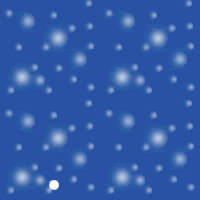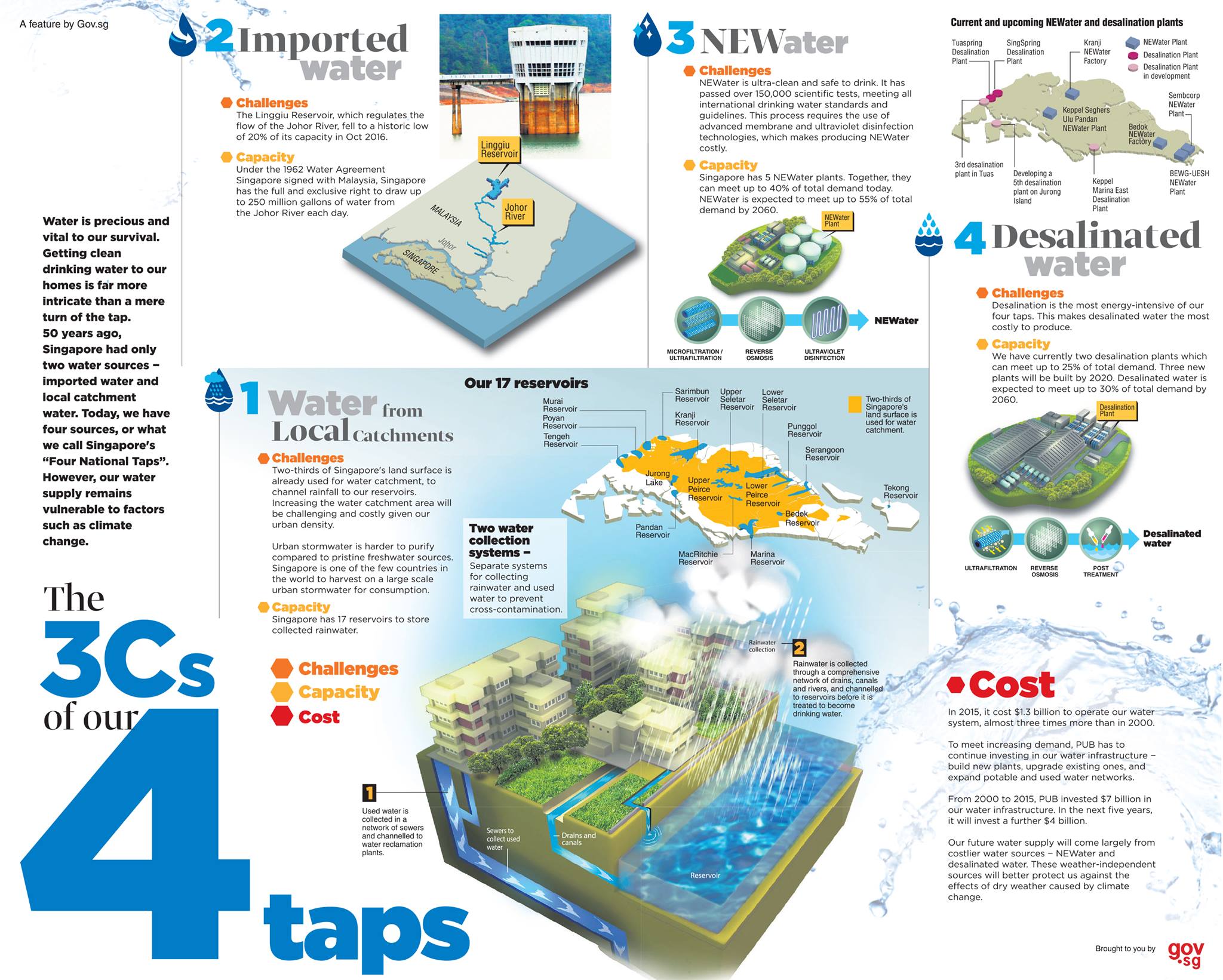WATER & SURVIVAL
water sustainability.
建国总理李光耀说过:
“水资源问题高于一切政策。
一切政策都必须向水资源问题屈服。”
Mr Lee said: “This (the water issue) dominated every other policy. Every other
policy had to bend at the knees for water survival.”![]()
|
|
| MARINA BARRAGE | RIVERS | RESERVIORS | ||
| RECYLING | DESALINATION | NEWATER | ||
| RESERVIORS | ||||
| MACRICTHE | PIERCE | UPPER PIERCE | SELETAR | PANDAN |
| BEDOK | ||||
| RIVERS | ||||
| SINGAPORE | KALLANG | SERANGOON | PUNGGOL | |
| The singapore | The water story | Pics of | |
|
LITTLE RED DOT
|
|||
|
|
|||
|
|
||||||||||||||||||
|
水源与绿化之旅 大家好! 今天我想与你分享新加坡 水源与绿化的故事。 水源支撑了我们花园城市. 在城市在花园中的概念中,我们的水体起着非常关键的作用. 建国总理李光耀说过: “水资源问题高于一切政策。 一切政策都必须向水资源问题屈服。” 水源与绿化之旅 你从何处来? 从天的泪滴,流向尘世的脉搏. 在河流中低唱。 你与我们形影相随, 到现代的城市脉络,。 你温暖每一天的起点, 也在溪流里轻诉岁月的新故事。 一个国家的水资源保护和安全可以改善和绿化环境. 我们就从新加坡的四大主要水源开始- 被称为“四大国家水龙头” 1 号水龙头:进口水。 2 号水龙头:本地集水区水库。 3 号水龙头:新生水。 4 号水龙头-海水淡化(淡化水)。 *********************** 1 号水龙头:进口水。 新加坡长期以来从柔佛河进口淡水。第二份协议到2061年到期, 每天2.5 亿加仑的水。(110万立方米) 进口水的可持续性一直是新加坡加强自给自足水源的动力之一。 2 号水龙头:本地集水区水库 让我先谈谈我们的水上乐园和河流. 雨水通过一个综合的排水网络、从35 条河流上把雨水收集到17 个水库蓄水池. 麦里芝蓄水池 这是最古老的水库之一 滨海蓄水池-滨海堤坝 我们从第15个水库开始说起. 它通过滨海堤坝将淡水和海水分隔,堤坝是新加坡创新水资源管理的典范。滨海堤坝是一座横跨350米宽的滨海湾水道的水坝,用于阻挡海水,同时提升了防洪能力。 滨海水库 形成新加坡市中心的第15个水库。 滨海蓄水池 收集包括新加坡河在内的五条主要河流的淡水资源.展示了如何通过长期规划实现环境保护与城市发展的双赢。 也为滨海湾区域提供了约10%的全国用水需求, 滨海湾花园-娱乐在花园中 以新加坡滨海湾,新加坡河和榜鹅水道的著名景点和活动例如慢跑、徒步旅行,骑自行车、划独木舟、皮划艇和其他娱乐选择. 新加坡滨海湾花园 于2008年建成, 是由三个风格各异的水岸花园,连接而成该花园占地101公顷-包括 擎天大树,花穹和云雾林,和正在修建的建国先驱纪念碑. 展示夜晚擎天大树的灯光表演和滨海湾金沙的灯光秀,呈现新加坡夜景的梦幻与浪漫. 建国先驱纪念碑来纪念和铭记建国历程. 新加坡河 新加坡河全长约3.2公里,上面有超过 14 座桥梁. 是新加坡历史最悠久Yōujiǔ的河流之一, 也是通往滨海湾的主要河流. 曾是新加坡殖民时期的贸易和经济中心,沿岸有驳船码头、克拉码头等重要商业和文化区域。 新加坡河的清理行动 (1977-1987年)将沿河的工业、牲畜农场、小型工厂和非法住户污染源-搬迁和迁移到其他地方。 不仅改善了生态环境,还推动了周边地区的经济与旅游发展。 榜鹅蓄水池和实龙岗蓄水池 最新的水库是榜鹅和实龙岗水库,它们是我们的第 16 和第 17 个水库。集水区覆盖Fùgài了新加坡三分之二的陆地面积。我们目前正在建设东海岸长岛项目第 18 个水库,该项目将连接滨海湾。到 2060 年,这将使新加坡的集水区面积增加到 90%。 榜鹅水道 榜鹅新镇内的水道是新加坡东北部的一个人工水道全长约4.2公里,贯穿整个社区, 它们通过水道连接形成了“新生水道,建成时间2011年,,也是新加坡首个生态友好型水上生活区的重要特色,以水上娱乐为主的集水区,吸引了许多喜欢划皮划艇和骑行的居民和游客。 榜鹅水道被称为“城市中的水岸绿洲”,旨在将自然与社区生活融合。水道旁有绿化走廊、湿地和生态堤岸,支持当地生物多样性。 长岛项目和18号水库 新加坡的长岛计划,旨在Zhǐ zài通过人工岛建设提供防洪保护、土地扩展和新的18号水库综合发展。这进一步增强新加坡的淡水储备和水资源管理能力。两者结合,不仅提升了新加坡的气候韧性,也为国家的可持续发展奠定了基础. 3 号水龙头:新生水 新生水是再生水或经过处理的废水(污水),用先进的水处理技术生产的超纯水,通过回收和净化污水制得。 使用多重处理技术,包括微滤、反渗透和紫外线消毒,确保水质纯净且符合饮用标准。 自2003年推出以来,新生水已成为新加坡的标志性创新,约占全国用水需求的40%。到 2060 年,这一比例将上升至 55%是可持续发展的典范。新生水主要用于工业用途和补充水库。 4 号水龙头-海水淡化(淡化水) 通过海水淡化技术,将咸水转化为可饮用的淡水。采用先进的反渗透技术,使水质达到饮用水标准。 新加坡目前有五座海水淡化厂(如大士海水淡化厂)。海水淡化约占全国水需求的10%-30%,是未来增长最快的水源之一。 综合水资源管理 依靠综合 水资源管理, 新加坡的“四大国家水龙头”是确保水资源可持续供应的重要基础。 通过本地集水区、新生水和海水淡化的创新应用,新加坡逐步减少对进口水的依赖,目标是到2061年实现水资源的完全自给自足。 结尾: 水源与绿化之旅是一个很好的起点让大家参考新加坡的水库和水资源管理。 希望大家通过今天的介绍,对新加坡的水库和它背后的智慧有更深的了解.
|
||||||||||||||||||||||||||||||||||||||||||||||||||||||||||||||||||||||||||||||||||||||||||||||||||||||||||||
|
###新加坡水源 与绿化的故事 (视频营销计划/针对中国游客) **1. 视频目的 使用新加坡水资源战略四大国家水龙头来解释新加坡水源 与绿化的故事. 可以了解一个国家的水资源保护和安全也可以改善和绿化环境,使用的真实例子和新加坡的美丽景点。 **2. 目的地** 介绍水库公园,河流和水岸绿洲,如麦里芝蓄水池、滨海湾和滨海湾花园,鱼尾狮公园、滨海湾堤坝、榜鹅水道和新加坡河 等地标性景点。 **3. 亮点** - **滨海湾灯光秀**:展示夜晚擎天大树的灯光表演和滨海湾金沙的灯光秀,呈现新加坡夜景的梦幻与浪漫。 - **滨海湾花园**:重点展示“云雾林”内的室内瀑布和“花穹”里的全球奇珍植物,展现奇幻的自然之美。 - **城市与自然的和谐共生**:将水库公园,河流和水岸绿洲与自然景观并置,突显新加坡的“花园城市”理念。 - **独特活动**:展示榜鹅水道和新加坡河,并强调慢跑、徒步旅行,骑自行车、划独木舟、皮划艇和其他娱乐选择。 。视频将以新加坡滨海湾和新加坡河的著名景点和活动为重点,传递自然和谐共存的魅力,激发观众的向往之情,提高新加坡作为旅游目的地的吸引力。 - ****4. 上传平台** - **微信视频号**:通过短视频和故事形式展示滨海湾的精彩亮点,配合精美图片和体验文字吸引观众,适合向中年和年轻观众推广。 - **小红书**:发布新加坡水资源战略四大国家水龙头旅行式的视频和图片,突出滨海湾的亮点及旅游小贴士,并鼓励用户互动和分享,为准备来新加坡的观众提供实用参考。 - **抖音**:利用短视频的形式快速展示 新加坡滨海湾,滨海湾花园、鱼尾狮公园、榜鹅水道和新加坡河的标志性景点和精彩瞬间,用动感音乐和创意特效增加观众的沉浸感,吸引年轻一代的游客。 **5. 目标受众** 希望来新加坡的中国游客及其他 邻国游客前往探索这些地区和水库. 尤其是年轻一代的都市白领、家庭游客和对旅行生活品质有较高要求的观众。也对于那些对独特旅行体验感兴趣的观众。
|
||||||||||||||||||||||||||||||||||||||||||||||||||||||||||||||||||||||||||||||||||||||||||||||||||||||||||||
|
水安全 新加坡天然淡水资源有限。 为确保可持续、可信赖的供水,该国有“四大国家水龙头”即四个主要水源: 新加坡三分之二的土地面积用作集水区,共有17个水库收集雨水。 第一项协议千2011年8月31 日到期。
第二项协议(1962年)允许新加坡每天从柔佛河抽取最多2.5亿加仑的水。该协议将于2061年到期。 新生水于2003年推出,用千工业和商业用途,也为饮用水供应做出贡献。 新生水仍然是新加坡水资源战略的重要组成部分,满足了该国约40%的用水需求。 截至2024年,共有5座新生水工厂。 它们提供可靠的淡水来源,不受降雨的影响。 截至2024年,共有5座海水淡化厂。 确保高效用水和高品质的水标准。 滨海堤坝 除了将海水与淡水分隔开之外,它还可作为阻挡涨潮的潮沙屏障。 大雨时,水库的水可以排入大海。 |
||||||||||||||||||||||||||||||||||||||||||||||||||||||||||||||||||||||||||||||||||||||||||||||||||||||||||||
|
有关4个水龙头供水情况: 根据公用事业局的网站,目前新加坡每日耗水量是430mgd(4亿3千万加仑)。 从柔佛进口的水可以满足50%的需求,新生水可以滿足约40%,海水淡化可达25%,其餘由本地集水区提供。另外目前家居用水约45%,剩余55%是工业及其他用途。这些数据会依其他因素而调整。
新生水 海水淡化 进口水及集水区
2018 40% 25% 35%
2030 50% 30% 20%
2060 55% 30% 15% |
||||||||||||||||||||||||||||||||||||||||||||||||||||||||||||||||||||||||||||||||||||||||||||||||||||||||||||
|
What are the 4 taps in Singapore? nown as the Four National Taps, this diversified water supply strategy ensures Singaporeans of a robust supply of water for generations to come.
|
||||||||||||||||||||||||||||||||||||||||||||||||||||||||||||||||||||||||||||||||||||||||||||||||||||||||||||
|
There are a currently 17 reservoirs which are designated as national water catchment areas. New reservoirs are Marina, Punggol and Serangoon. ( from 14 to 17 ). They are managed by the Public Utilities Board (PUB) of Singapore.[1][2]
|
||||||||||||||||||||||||||||||||||||||||||||||||||||||||||||||||||||||||||||||||||||||||||||||||||||||||||||
|
The NEWater process recycles our treated used water into ultra-clean,
high-grade reclaimed water, cushioning our water supply against dry
weather and moving Singapore towards water sustainability. NEWater’s genesis dates back to the 1970s, when the Singapore
government commissioned a study to determine the feasibility of
producing reclaimed water. Although the study found it was technically
possible, the technology’s high cost and unproven reliability then were
insurmountable concerns. In the following year, we officially opened the first two NEWater
plants at Bedok and Kranji, and the NEWater Visitor Centre, a water
museum to showcase our journey towards water sustainability.
|
||||||||||||||||||||||||||||||||||||||||||||||||||||||||||||||||||||||||||||||||||||||||||||||||||||||||||||
NEWater Production Process
Stage 1 –
Microfiltration/Ultrafiltration |
NEWater 生产过程 第 1 阶段 - 微滤/超滤wēi lǜ/chāo lǜ 通常,NEWater 生产过程的第一阶段称为微滤 (MF) 或超滤 (UF)。在此过程中,处理过的废水通过膜过滤掉mó guòlǜ diào微小颗粒和细菌。 PUB 一直采用膜生物反应器 (MBR) 技术进行水回收。MBR 是一种三合一解决方案,将传统生物反应器、二次沉淀池和 MF/UF 结合在一个步骤中。bùzhòu 因此,在适用的情况下,MF/UF 工艺可以用单步 MBR 工艺代替。 第 2 阶段 - 反渗透fǎn shèntòu NEWater 生产过程的第二阶段称为反渗透 (RO),其中使用具有非常小孔的半透膜。这允许水分子通过,同时留下病毒、细菌、重金属、芳香烃、杀虫剂等污染物。shā chóng jì děng wūrǎn wù. 第 3 阶段 – 紫外线消毒 经过 RO 阶段后,水质已达到高品质。NEWater 生产过程的第三阶段是紫外线 (UV) 消毒,可灭活任何细菌和病毒的痕迹。此过程可作为额外的安全措施,zuòwéi éwài de ānquán cuòshī,以保证 NEWater 的纯度。 |
|||||||||||||||||||||||||||||||||||||||||||||||||||||||||||||||||||||||||||||||||||||||||||||||||||||||||||
|
The State of Johore and the City Council of Singapore signed two
long-term Water Agreements.
The State of Johore and the City Council of Singapore signed two long-term Water Agreements. The first Water Agreement was signed in 1961 and expired in August 2011. Under this Agreement, Singapore was entitled to draw an unrestricted quantity of raw water from the Tebrau and Scudai Rivers. In return, the agreement stipulated that Singapore would provide Johor with treated water amounting to 12% of the water that we had imported. When the 1961 Water Agreement expired on 31 August 2011, Singapore handed the Johor State government the Gunong Pulai and Scudai waterworks as well as the pump houses at Pontian and Tebrau which we had been operating and maintaining at our own cost. These facilities were handed to them free of charge and in good working order. The second Water Agreement was signed in 1962 and will expire in 2061. It entitles Singapore to draw and use 250 million gallons of raw water per day from the Johor River. In return, we are obliged to provide Johor with treated water up to 2% of the water we import. PUB draws water from the Johor River and treats the water at the Johor River Waterworks located near Kota Tinggi in Johor. The water we import from Johor is one of our “Four National Taps”.
|
柔佛州与新加坡市政厅签署了两项长期供水协议。 第一份供水协议于 1961 年签署,并于 2011 年 8 月到期。根据该协议,新加坡有权从地不佬河和士古来河抽取无限制数量的原水。作为回报,协议规定新加坡将向柔佛提供相当于我们进口水量的 12% 的处理过的水。1961 年供水协议于 2011 年 8 月 31 日到期时,新加坡将由我们自费运营和维护的 Gunong Pulai 和 Scudai 水厂以及位于笨珍和地不佬的泵房移交给柔佛州政府。这些设施是免费移交给他们的,并且运行良好。 第二份供水协议于 1962 年签署, 将于 2061 年到期。 根据该协议,新加坡有权每天从柔佛河抽取和使用 2.5 亿加仑的原水。 作为回报,我们有义务向柔佛提供处理过的水,最高可达我们进口水量的 2%。公用事业局从柔佛河抽水,并在位于柔佛州哥打丁宜附近的柔佛河水厂处理水。 我们从柔佛进口的水是我们的“四大国家水龙头”之一。 |
|||||||||||||||||||||||||||||||||||||||||||||||||||||||||||||||||||||||||||||||||||||||||||||||||||||||||||
|
WATER RESOURCES - 4 MAJOR TAPS
Reservoirs 17 http://www.pub.gov.sg/water/Pages/LocalCatchment.aspx
Rivers 35
|
||||||||||||||||||||||||||||||||||||||||||||||||||||||||||||||||||||||||||||||||||||||||||||||||||||||||||||
|
|
||||||||||||||||||||||||||||||||||||||||||||||||||||||||||||||||||||||||||||||||||||||||||||||||||||||||||||

